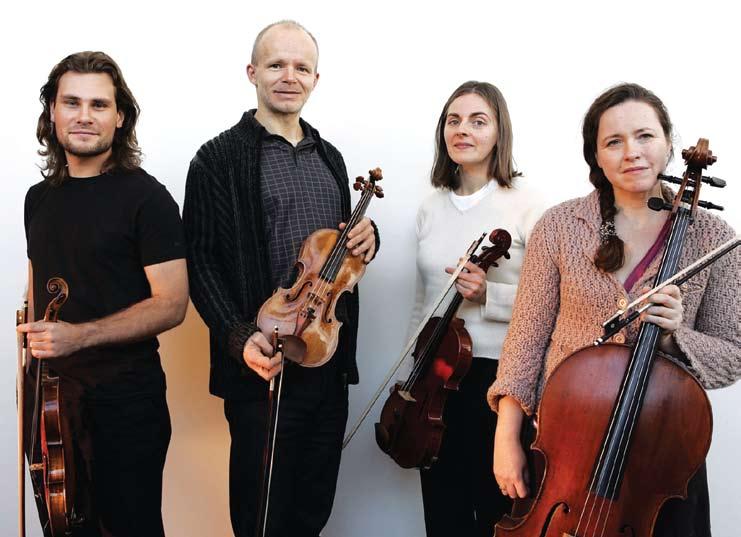薩赫米亞四重奏 Zehetmair Quartet
庫巴.雅各域治 Kuba Jakowicz
小提琴 violin
湯馬士.薩赫米亞 Thomas Zehetmair
小提琴 violin
露思.基利厄斯 Ruth Killius
中提琴 viola
烏爾蘇拉.史密夫 Ursula Smith
大提琴 cello
薩赫米亞四重奏於1994年秋成立,廣 受觀眾和樂評推崇,迅即成為世界頂 尖弦樂四重奏。1998年春天首次巡迴 演出後,到美國及日本演出的邀約不 斷,還有周年歐洲巡迴音樂會。薩赫 米亞四重奏享譽各大國際藝術節,如 愛丁堡音樂節、赫爾辛基音樂節和德 國的石荷州音樂節。2006年春,薩赫 米亞四重奏巡迴歐洲各地演出,包括 維也納、柏林、科隆、蘇黎世、馬德 里、里斯本及曼徹斯特,空前成功。
2007/2008樂季 , 薩赫米亞四重奏在 藝術上更上層樓,包括在倫敦威格摩 爾音樂廳演出全套舒曼弦樂四重奏, 以及世界首演由科隆音樂有限公司委 約海因茲.霍利格創作的第二弦樂四 重奏。
樂隊2000年推出首張唱片,巴托克第 四和哈特曼第一弦樂四重奏,跟着推 出的舒曼第一和第三弦樂四重奏,兩 張由ECM出版的專輯都屢獲獎項,繼 有德國唱片評論大獎季度獎、留聲機 雜誌2003年度最佳唱片、金音叉唱片 獎、2004年荷蘭的愛迪生古典音樂大 獎、比利時的凱西利亞獎和克拉最佳 國際唱片獎。最新一張唱片由ECM於 2007年3月發行,收錄了亨德密特第 四和巴托克第五弦樂四重奏,並在巴 黎獲頒金音叉唱片獎。
2008/09年樂季甫開始 , 薩赫米亞四 重奏即參與了幾個國際夏令音樂節, 如赫爾辛基音樂節、石荷州音樂節和 斯特薩音樂節;未來的演出包括2009 年4月在紐約舉行兩場音樂會,慶祝作 曲家卡特百歲生辰,以及在蒙地卡羅 春天藝術節駐節演出。
Founded in autumn 1994, the Zehetmair Quartet was enthusiastically applauded by audiences and highly esteemed by the press, and soon came to be seen as one of the most important string quartets in the world. The Zehetmair Quartet embarked upon its first concert tour in spring 1998; this led to bookings and invitations from leading concert halls in the US and Japan which complemented the Quartet’s annual European tours. The Zehetmair Quartet is a welcome guest at such famous international festivals as the Edinburgh Festival, Helsinki Festival and Schleswig-Holstein Musik Festival. In spring 2006 a very successful concert tour led the Zehetmair Quartet throughout Europe with appearances in Vienna, Berlin, Cologne, Zurich, Madrid, Lisbon and Manchester.
The artistic challenges taken up by the Zehetmair Quartet in the 2007/08 season included a performance of Robert Schumann’s string quartets at the Wigmore Hall in London and the world premiere of Heinz Holliger's String Quartet No. 2 commissioned by Cologne Music Ltd. for the Zehetmair Quartet.
Their first CD featuring Bartók’s 4th and Hartmann’s 1st quartet was released in 2000 on the ECM label and was awarded the Quarterly Prize by the Deutsche Schallplattenkritik. Their recording of, Schumann’s 1st and 3rd string quartets (also on ECM), won the Gramophone Award (2003 Record of the Year), the 2004 Diapason d’Or of the Year, the Dutch Edison Classical Music Award 2004, the Belgian Caecilia Award and the Klara Award for the best international production of the year. The release of their latest CD with Hindemith’s 4th and Bartók’s 5th string quartets on ECM was released in March 2007 and subsequently received the Diapason d’Or of the Year at a ceremony in Paris.
The 2008/09 season began with several invitations to internationally renowned summer festivals: Helsinki Festival, Schleswig-Holstein Music Festival and Stresa Festival. Another upcoming highlights will be two performances in New York in April to commemorate John Elliott Carter’s 100th birthday as well as a residency at the Printemps des Arts Festival in Monte Carlo.
亨德密特
第四弦樂四重奏,作品 22
弦樂四重奏可能幫亨德密特保住性 命;第一次世界大戰時,他被徵入德 國軍隊,遇上喜愛音樂的軍官,於是 獲留在軍中演奏弦樂四重奏,又負責 軍樂隊的低音鼓,直到戰事結束,他 仍無須上前線作戰。
戰後,亨德密特重回法蘭克福歌劇院 當樂團團長。1920年代魏瑪時期的德 國,創作上百家爭鳴,在這個叫人興 奮的時代,亨德密特轉為從事創作, 他寫的獨幕歌劇三部曲,受當時的表 現派影響,震撼性的風格立即使他惡 名遠揚。他繼續演出四重奏以發展室 樂,並創立阿瑪爾四重奏,主力演奏 當代作品,而他自己負責樂團的中提 琴。亨德密特亦是多瑙埃興根一個新 音樂節的核心搞手,創造演出平台, 除了自己的作品,也讓其他當時前衛 的作曲家有一展身手的機會。1922 年,阿瑪爾四重奏在音樂節中首演這 首第四弦樂四重奏,並錄了音,我們 可一聽亨德密特演奏自己的作品。
此曲作於1921年尾,包含五個樂章, 反映了當時亨德密特探索的一些音樂 語言。果敢的和聲和進取的節奏糅合 新巴羅克風格的清澈線條,標誌作曲 家開始擺脫浪漫主義,趨向「客觀」 表達風格的新方向。即使在他最大膽 嘗試的時期,亨德密特的音樂仍然備 受巴羅克前輩的影響,例如在賦格曲 式的慢板首樂章,就有巴赫的影子, 但這「巴赫」畢竟是在1920年代的德 國,音樂的機鋒白熱化,然後重回初 段的約制;接着的〈諧謔曲〉由帶着 原始主義風格的旋律推進。
在結構上和情感上,第三樂章都是整 首樂曲的中心,這個慢樂章有如夢幻
Paul Hindemith String Quartet No.
4, Op. 22
The string quartet may very well have saved Paul Hindemith’s life. During the First World War, when he was drafted into the German army, Hindemith entertained his music-loving commanding officers by playing in a quartet; his musical duties (which included pounding the bass drum for the military band) kept him, until the war’s final months at least, at a safe remove from the battle lines.
After the war, Hindemith returned to his position as concertmaster of the Frankfurt Opera. He came of age as a composer during the intoxicating period of creative ferment of 1920s Weimar Germany. A trilogy of shocking one-act operas drawing on the expressionist idiom of the period first gained Hindemith widespread notoriety. While he continued pursuing chamber music by participating in quartets, including one he founded to play contemporary music (the Amar Quartet, with the composer as its violist). Hindemith was also active as the organiser of a prominent new music festival at Donaueschingen, which introduced recent efforts from fellow avant-garde composers, along with his own compositions. In 1922 the Amar Quartet debuted the String Quartet No. 4 at the festival (they also made a recording, in which we can hear Hindemith playing his own music).
The five-movement Quartet (composed in late 1921) reflects some of the musical languages Hindemith was exploring at the time. It combines daring harmonies and aggressive rhythms with the neo-baroque, linear clarity that would soon point Hindemith in a new direction toward an anti-romantic, “objective” style of expression. Even in his most experimental period, Hindemith was saturated in the music of his baroque forbears: Bach pays a visit more than once, such as in the slow opening fugue-like movement. But this is Bach in 1920s Germany, and the musical argument intensifies to a fever pitch before returning to the restraint of the opening. The ensuing Scherzo is propelled by primitivistic rhythmic accents.
It makes a startling contrast with the dreamy night music of the slow movement that stands at the work’s emotional and structural centre. The latter calls for mutes on the strings throughout, adding a veiled quality that Hindemith varies with plucked pulses
的夜曲,與之前的樂章對比強烈;弦 部用弱音器奏出,製造含糊的音質, 並由伴奏中的彈撥節拍點綴。短小而 華麗的第四樂章發揮間奏的作用,不 作稍停即進入終樂章的〈迴旋曲〉, 由中提琴帶領節奏生動的音調開始; 這個調子有力展現了亨德密特式對 位,牽着音樂穿過蜿蜒曲折的半音 叢林。
舒曼
A 小調第一弦樂四重奏,作品 41 身為書商之子,舒曼融合他對文學和 音樂的細膩感覺,創造出超凡原創的 作品,例如早期的一些鋼琴獨奏,不 但替他奠定個人風格,更有助界定剛 冒起的浪漫主義美學。即在創作生涯 的早年,舒曼已開始探索較大型的室 樂種類,他在青少年時代已經寫過一 首鋼琴四重奏,卻從未出版。1841 年,他全情投入室樂,該年夏季,他 迸發出一股創作熱情,一口氣寫了一
套三首弦樂四重奏,並稱作品為他的 「四重奏念頭」,但這套作品是舒曼棄 用鋼琴的惟一室樂之作,鋼琴不但是 舒曼個性的延伸,亦代表他妻子克拉 拉的音樂成就;在寫這幾首四重奏之 前的數月,舒曼陪伴克拉拉在歐洲巡 迴演出,卻發現克拉拉的鋒頭蓋過了 自己。後來他獨自回家,我們可以想 像他當時是極須重振自信的。
這幾首四重奏亦體現了舒曼怎樣融會 前人的精髓,在着手寫作之前,他醉 心研習對位,分析維也納大師們四重 奏中的佳品,把所得塑造成第一弦樂 四重奏的音樂意念。A小調慢引子賦 格式樂段開始了樂曲,到了第一樂章 的〈快板〉,戲劇性地移到F大調;
in the accompaniment. The short but showy fourth movement serves as an interlude leading without break into the rondo finale, which begins with a rhythmically lively tune announced by the viola. This tune proves highly susceptible to Hindemith’s brand of counterpoint and also carries the momentum forward through a thicket of chromatic twists and turns.
Robert Schumann
String Quartet No. 1 in A minor, Op. 41
The son of a bookseller, Robert Schumann fused his literary and musical sensibilities into extraordinarily original compositions such as the solo piano pieces in which he first found his voice and which helped define the emerging romantic aesthetic. Yet even in his early years as a composer, Schumann had experimented with the larger-scale forms of chamber music (including an unpublished piano quartet written when he was a teenager). He was ready to turn his attention whole-heartedly to the chamber-music medium in 1842. In an outburst of creative enthusiasm that summer, Schumann composed his set of three string quartets in rapid succession. He referred to these as his “quartet-thoughts”, and they are his only chamber music that omits the piano the instrument that was an extension of his personality. It was also the instrument representing his wife Clara’s success as a musician. In the months before setting about composing the quartets, Schumann had accompanied Clara part way through a European piano tour she was giving, when he found himself all but eclipsed by the attention she received. He returned home alone, needing, one might assume, a new boost of selfconfidence.
In a way, too, the quartets mark Schumann’s attempts to absorb the legacy of the past. He immersed himself in studying counterpoint as well as the pinnacles of the quartet genre from the Viennese masters in the months before he began composing his own. Both of these preoccupations inform the musical thought of the String Quartet No. 1. Schumann begins with a






